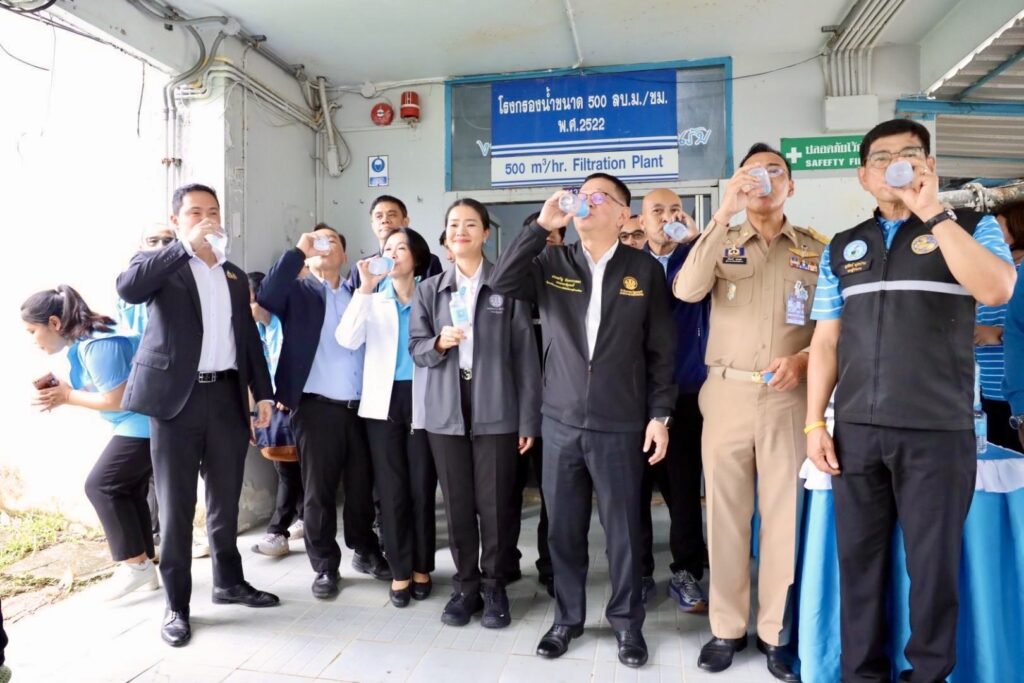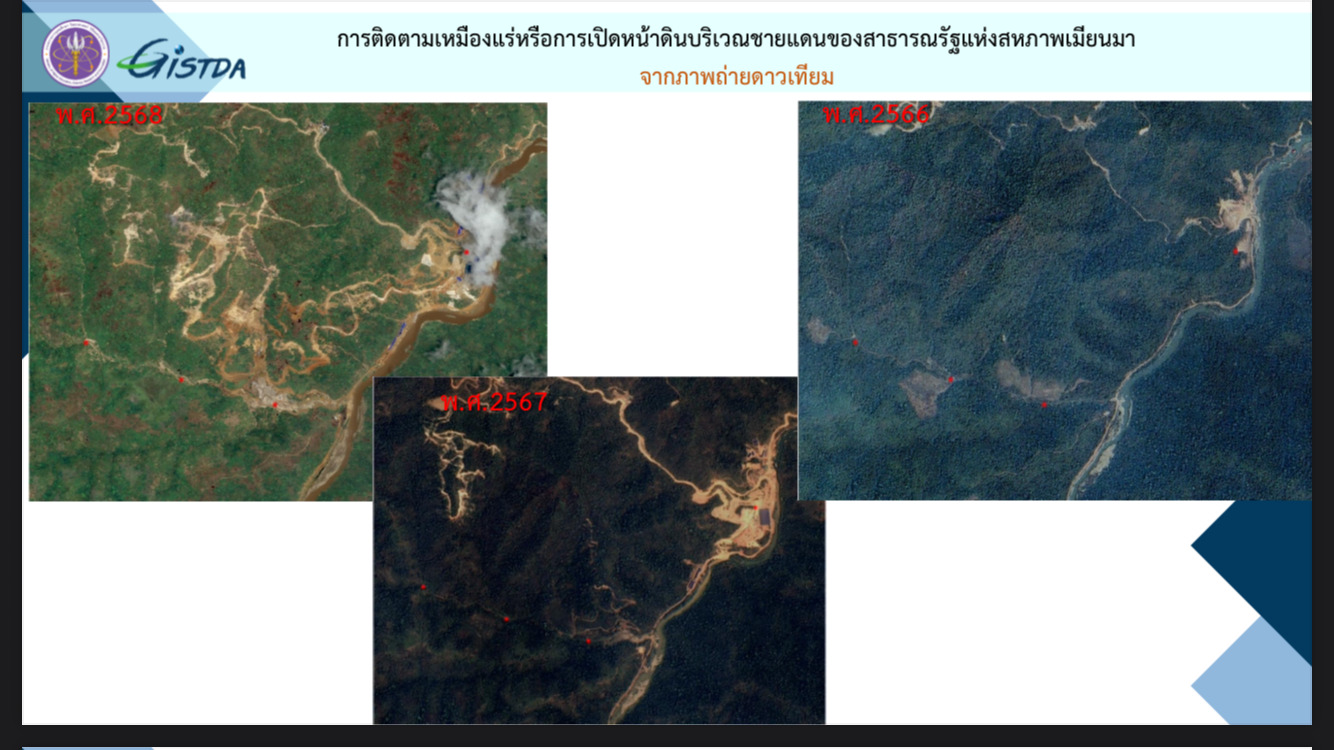The government’s main directive to address the prime causes of the problem is correcting mining upstream with good practices, whereas civil society and local residents demand that mining activities upstream must be stopped, so that toxic substances are not discharged downstream
Deputy PM Prasert Chantararuangthong, supervising Monre and related agencies, has updated progress in addressing the toxic contamination issue in Kok and Sai Rivers during his inspection yesterday. The rivers originate in Myanmar’s watersheds bordering Thailand and Myanmar in the North and flow through Chiang Rai and Chiang Mai provinces before flowing down to the Mekong River in Chiang Rai. Extensive mining activities are captured and reported upstream, subject to speculation that they discharge toxic substances downstream and contaminate the rivers in Thailand and the Mekong further down.
As the Chair of the newly set up subcommittee under the National Environment Board (NEB) to solve water quality in inland water sources, Mr. Prasert said talks at different levels and in different frameworks have been initiated to try to address the issue, but the government-to-government is what he expects the most.
The Deputy PM said a new international cooperation working group has also been set up to officially kickstart discussions with Myanmar, and the government of Myanmar has responded positively, agreeing to cooperate. The dates are being set, and he will lead the team himself to inspect the situation in Myanmar as well as share guidelines or good practices in mining with the neighbouring country, the Deputy PM further said.
“The government has now acquired information from concerned agencies, including the Royal Thai Survey Department and GISTDA, sufficient for the talks”, the Deputy PM said, underlining that the issue is sensitive and the government needs to be ensured before taking action.
So far, it has assigned the Department of Pollution Control (PCD) to join with other concerned agencies to examine levels of turbidity and toxicity in inland water sources, aquatic animals, agricultural products, as well as public health, Mr. Prasert said. Almost all of them have been found to be at normal levels, except for arsenic in water in the Kok River from the border down through Tha Ton in Mae Ai district in Chiang Mai to Chiang Rai’s Muang District, the city’s downtown.
But once the water reaches a checkdam in Muang District, the arsenic level below the dam has dropped and returned to normal, Mr. Prasert noted. This prompts the government to come up with an idea to construct check dams downstream to intercept toxic substances, and concerned agencies have been assigned to conduct a study of appropriate types of check dams if built, he said.
However, Chiang Rai residents should avoid direct consumption of the water from the rivers. It must be processed first, Mr. Prasert pointed out, while assuring that tap water in the city is safe. To ensure safety, Chiang Rai Municipality has been instructed to look for alternatives for its raw water for tap water production, and the Mae Lao River, originating in the mountains inland, is among the options.
Mr. Prasert has also declined speculation that some fish found to be infected in the rivers are infected with parasites, not toxic substances. No arsenic has been detected in the fish, as feared, he added.

People’s calls
Earlier in late April, the recently set up people’s network of Kok and Sai River basins, representing residents and academics in the Kok and Sai River Basins in Chiang Rai and Chiang Mai provinces, released an open letter addressed to Prime Minister Paetongtarn Shinawatra to call for her to urgently address the issue. They said the rivers had apparently been contaminated by heavy metals released from watersheds upstream, and the issue needed to be addressed urgently, as the rainy season was approaching.
The group cited some recent reports that on the watersheds upstream in Myanmar, there were mining activities that had opened up the soil surface extensively, prompting it to be deluted and flushed away downstream.
These could be seen via Google Earth, the group said, also citing the Department of Pollution Control (PCD) that reported in 2023 that at least 14 minging activities were undertaken near the Thai-Myanmar border in the North, and five of them were located close to the rivers that run into Thailand, thus posing risks to the river residents living along the border.
Despite the rising challenge, the group had learned that there were no comprehensive monitoring and solutions in place for the people. Last year, their members had just suffered from heavy flooding, and the government’s reparations provided were not sufficient to cover their losses. The group was worried about the situation as there was, at that time, only around one month left before the rainy season again. So, it decided to propose some measures for the PM and her government to urgently address.
The group called on a new working group to specifically work on this issue, comprising stakeholders from state agencies as well as civil society and academics in the region to help address the challenge and come up with proportionate solutions, including the new scientific water quality monitoring station in Chiang Rai. The studies should also be extended to cover transboundary impacts in the basins.
Disaster preparedness and response measures should be implemented in the basins systematically and inclusively, whereas accountable and transparent communication should be established alongside. Last but not least, the government should work with the government of Myanmar as well as armed groups in the area to resolve this challenge together. Negotiations among concerned parties, Thailand, Myanmar, ethnic armed groups, and China, may be necessary, the group proposed.
As reported by Transborder News and Shan Human Rights Foundation, the upstream area has been opened up for gold mining under the influence of the United Wa State Army (UWSA). On March 14 this year, the issue was first exposed publicly following a peaceful march on the International Day of Action for Rivers by Tha Ton residents in the border district of Mae Ai, where the Kok River from Myanmar’s Shan State flows into Thailand.

Aerial photographs have revealed the opening of the soil in a wide area of the Kok watershed, the foundation claimed. Some gold mines are owned by Chinese investors who allegedly provide support to the Wa Army, it added. The issue has recently been exacerbated by the speculation over Rare Earth mining in the area as well.
The Thai Lower House’s standing committee on natural resources, land, and environment has also accepted the case for examination. According to the committee, the latest report of the Natural Resources and Environment Office, District 1, Chiang Mai Province, in April found arsenic, lead, and chromium more than double the standard in the Kok River, Mae Ai District, Chiang Mai Province. Gold mining from the neighbouring country was suspected.
Despite the recent set-up of Mr. Prasert’s new subcommittee and other assignments by the PM, the group has criticised the government’s action as still being sluggish and disproportionate to the problem. Along with Chiang Rai residents, they have recently run a campaign to invite Chiang Rai and Chiang Mai residents to call for more action, including the permanent cessation of the mining activities upstream. Another campaign is planned for the upcoming World Environment Day on June 5.
l GISTDA’s satellite images show changes in the soil surface from mining activities near the Thailand-Myanmar border.
Indie • in-depth online news agency
to “bridge the gap” and “connect the dots” with critical and constructive minds on development and environmental policies in Thailand and the Mekong region; to deliver meaningful messages and create the big picture critical to public understanding and decision-making, thus truly being the public’s critical voice




